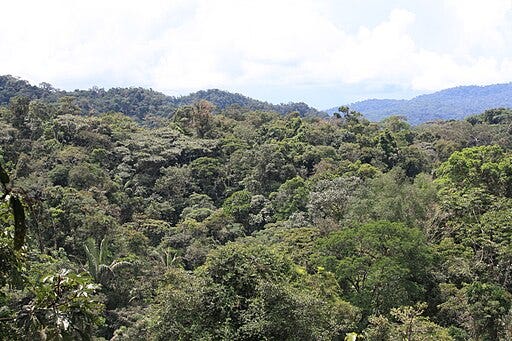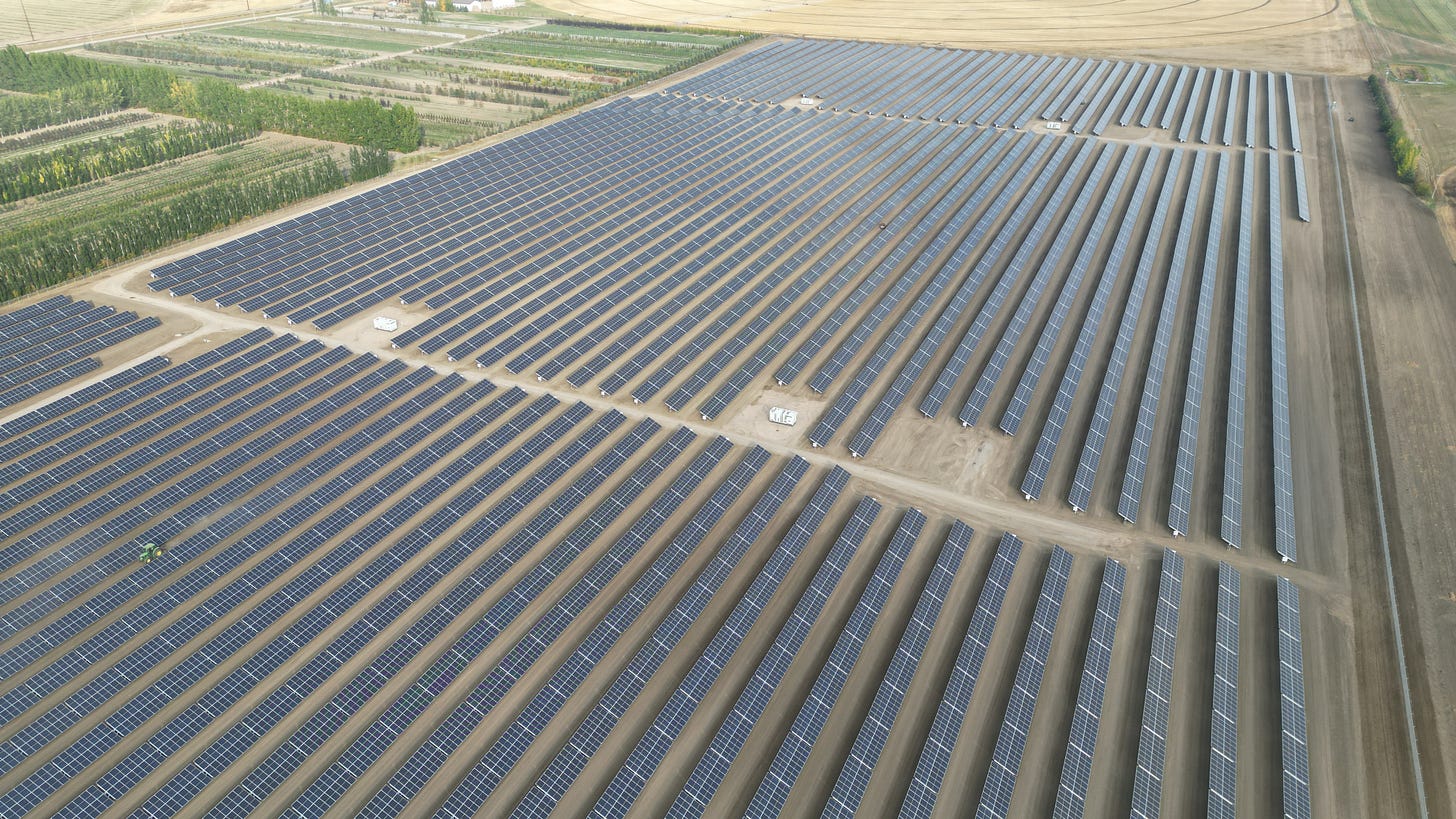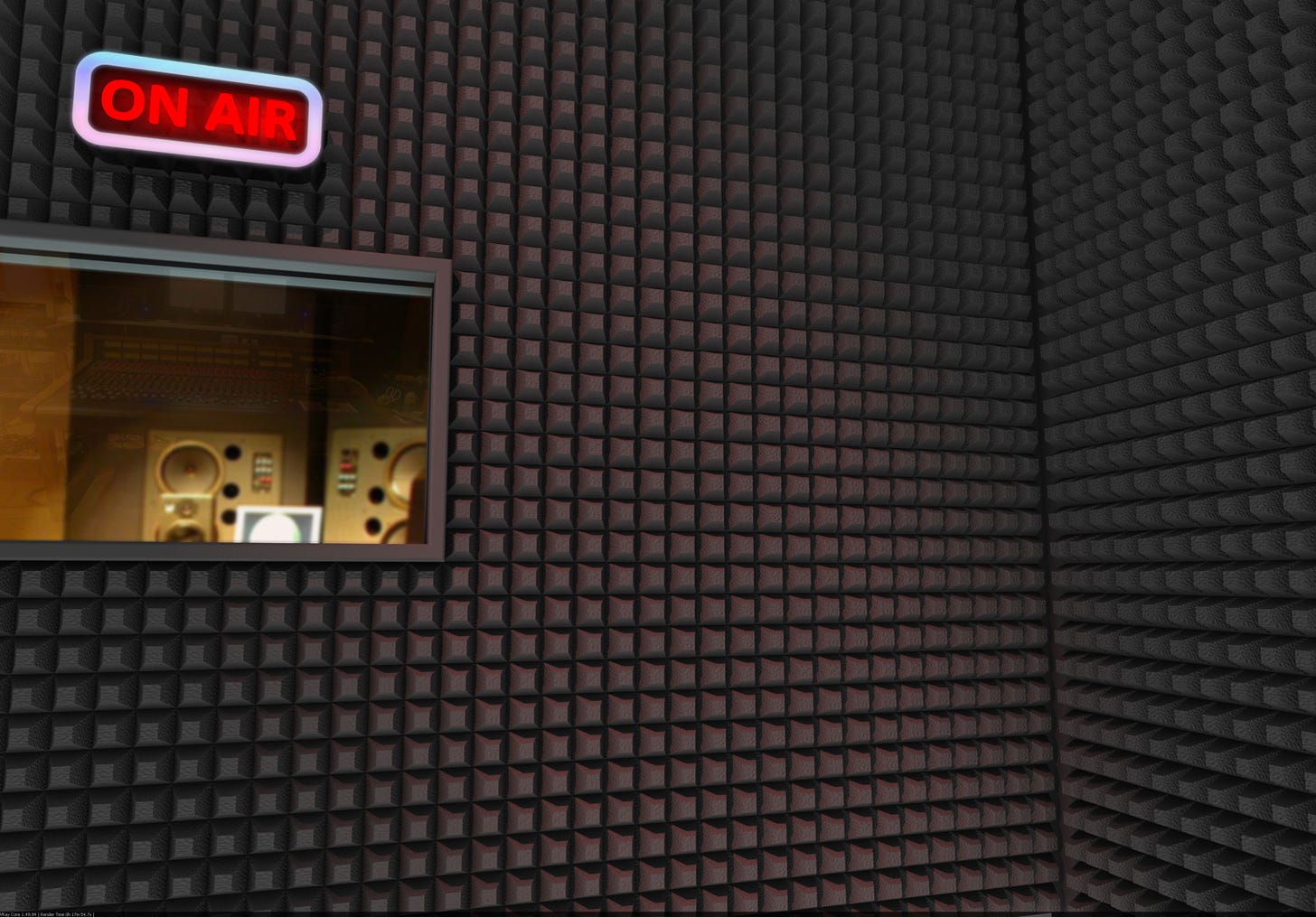1 Week, 7 Stories # 25
Falling rainforest, falling solar panels, and falling for another conspiracy theory
Every edition features 7 stories, from the past week. I’ll draw on my background in media, journalism, agriculture, biotech, and renewable energy to come up with an interesting selection and do my best to offer some context.
Sometimes built around a theme, sometimes random, but with a Canadian twist.
Al Jazeera is airing a series it calls the Dying Earth and it is guaranteed to leave you wondering about the future of our little blue planet. This week’s episode was ‘The Final Breath: The threat to life in the Amazon’. It outlines the ongoing deforestation of the Amazon, the role Indigenous communities are playing in controlling it, and how resource extraction is allowed to happen with little regard for the environment. I was struck by the dismissive attitude of Fernando Santos, Ecuador’s former oil minister. He laughs and says he too would like to live in the Garden of Eden, but oil production must continue, led by PetroEcuador, the state-owned oil company.
Meanwhile Brazil is moving ahead with plans that will accelerate deforestation in an agricultural development zone according to a Phys.Org story and an article in Perspectives in Ecology and Conservation. Researchers used satellite data and data from previous studies to conclude that forest loss was increasing in protected areas and there was a lack of environmental impact studies.
Peru has the 2nd largest rainforest area behind Brazil and is currently rolling back regulations which the Context (a Thomson Reuters Foundation platform) refers to as an “anti-forest law”. In 2022, Peru’s forest loss increased by 6% and the new law is an incentive for even more deforestation.
South America has lost 30% of its primary forest cover since 2001 and despite efforts by some countries to exercise more control, illegal mining and agricultural activities have made it even more challenging. Columbia was making headway, but armed groups are profiting from illegal deforestation and have used Amazon forests as a “bargaining chip”, according to The Guardian.
There is a reason the Amazon rainforest has been called the “lungs of the earth”. It has been around for 10 million years and at the end of the 20th century was home to 390 billion trees which release nearly one quarter of the planet’s oxygen.
Read what an Indigenous leader has to say about the importance of her Amazon homeland.
Widespread use of solar power generation is still relatively new, and the industry is experiencing growing pains as the marketplace sorts out how solar fits into the global economy.
Prices for solar panels have fallen so far that two of the industry’s biggest firms say that “prices are near the bottom” according to a Bloomberg story. The steep drop comes down to the basic law of supply and demand we learned about in 1st year economics. High prices and high demand led to more manufacturers entering the market which is now faced with excess supply amid a slower growth in demand. Chinese-subsidized panels have started to flood the US market to burn of an oversupply and that has forced some solar manufacturing companies to ask for federal action. However, the US Inflation Reduction Act, tax credits, and tariffs on imports has given US solar panel production some relief. A couple Canadian companies are benefitting from those south of the border incentives by expanding their American operations. The MIT Technology Review digs into Canadian Solar’s expansion and a podcast from ARC Energy Research Institute looks at Canadian competitiveness with the President and CEO of Silfab Solar.
The falling price of panels and battery storage led The Independent to suggest that fossil fuels are ‘becoming obsolete’. Realistically that is an exaggeration, but it is certainly one of the factors in the undeniable trend to residential and commercial solar power use.
How’s the job going? You happy in your role?
A recent job satisfaction survey in the United States found that 62.7% of the respondents seemed to be positive about their workplace. Hybrid and remote workers led the pack of satisfied workers while women were less satisfied than men for the 6th consecutive year. The Wall Street Journal offers a good overview of the survey and points out an anomaly that may come into play in future surveys. While workers expressed overall satisfaction, when the categories are broken down workers were less satisfied. It seems they are happy to have a job but are worried about specific aspects of their careers.
Canadian workers have a similar take on their jobs with only 44% saying they are dissatisfied. Similar results from the Happiness@Work Index (a new one to me!) were highlighted on the HRD Canada website.
And it is not money that is making workers generally satisfied (or at least not dissatisfied!) with their jobs. Work-life balance, recognition and support in the workplace, health insurance, and flexibility top the list.
Like the American results though, right now having a job might not be enough to maintain worker satisfaction by this time next year.
On Monday, journalists at the Italian public broadcaster Rai went on strike saying that the government was exercising “suffocating control”.
It is important to understand the difference between a national public broadcaster and a state-controlled media outlet. State controlled media are owned and operated by a government (North Korea, Soviet Union, China) and are there to shape a specific government agenda. Public broadcasters such as RAI are supposed to serve the public interest and are arms-length from the government of the day (CBC, BBC, PBS). While we tend to think that the rise of partisan media is relatively new, it does go back. Way back. In 130 BCE the Acta Diurna (Daily Public Record) was posted in public places in Rome by the government. Thomas Jefferson and Alexander Hamilton each had their own newspapers to spread their opposing ideas. In the 1800s Canadian newspapers were often edited or owned by politicians such as William Lyon McKenzie who owned the Colonial Advocate.
In general (there are always exceptions!) public broadcasters are impartial, serve diverse communities, and are accountable to a Board and to the public. In the case of RAI, the Board is now largely made up of people chosen by their party affiliation, which the journalists’ union says is a “ sign of occupation of the public service”.
When I was working with political parties and media in Croatia in the nineties as they dealt with the aftermath of the conflict there, the discussion inevitably came around to what a free and open media should look like. Much like the discussions taking place around the world today. And like today, much of that discussion concluded each party and political affiliation should have their own media outlet. The debate continues in 2024 and the notion of a truly free and open media continues to lose ground.
As a report from the Asia-Pacific Development, Diplomacy & Defence Dialogue (AP4D) thinktank noted, trusted news outlets are “staring down the barrel of yet another crisis”.
I would add, at home and abroad.
A New York Times story on Monday sent me down the biotech path. A 12-year-old boy became the first patient outside of clinical trials to start a new sickle cell gene therapy. It is a significant step in the treatment, but it is slow and expensive - $3.1 million – which for the young Washington DC boy is covered by his family’s health insurance. In Canada, 6,000 people are living with sickle cell disease. There is currently no approved gene therapy available here for patients and it could be some time before that changes. The genetic condition results in “sticky” red blood cells that do not move smoothly through the body causing intense periods of pain. It is most common among the black community and significantly reduces life expectancy. This new commercially available treatment (called Lyufgenia) involves removing the patient’s stem cells, genetically modifying the gene responsible for the condition, and delivering them back into the patient to promote the production of properly functioning red blood cells. The complexity of the treatment, its costs, and the potential side effects means that even it was approved in Canada, access is an issue. Nevertheless, gene therapy has arrived says Mayo Clinic Press and we need to find out the best ways to apply it.
Tick season has arrived, and it deserves your attention and for the quick overview head – where else – to TickTalk Canada.
But we’ll dig a little deeper than basic advice.
The tiny, blacklegged tick carries a pretty hefty wallop for its size. Ticks are not a fan of cold weather and thanks to a warming climate with mild winters, ticks are rubbing their 8 little legs with glee. The latest news suggests they have their eyes on Manitoba which has already had more sightings than last year, Quebec, and Toronto which just had its warmest winter on record. Birds are changing their migratory patterns and often take along a tick or 2 as a passenger, helping them to expand further north.
The worst thing about ticks is that they can carry Lyme disease which causes fever, headaches, fatigue, and a skin rash. It is hard to diagnose and unless treated can be persistent for years and will wear you down. The Canadian Lyme Disease Foundation has been around for 2 decades and frequently has called for more research because they feel the public healthcare has failed Lyme patients. In 2009 there were 144 reported cases of Lyme disease and by 2021 there were 3,147 confirmed cases in Canada. In the U.S. where ticks are more prevalent there are more than 300,000 cases per year. The disease is not transmitted from person to person, but as the cases and the number of ticks continue to increase, the higher the chance of getting it from a tick bite.
Just one more example of the consequences of a warming climate.
There are a lot of problems facing the world today that require immediate attention. Feeding an ever-increasing global population is one of those problems and there are a number of ways to feed the 9.7 billion people who will want something to eat in 2050. One of the options on the menu is lab grown meat or cultured meat which I have written about in the past. It is one small part of the solution but has become a flash point for politicians who don’t seem to be willing to take on the larger challenge of food security at home and abroad.
I’m talking about Florida, where Governor Ron DeSantis has said cultured meat is part of a global plot to completely ban livestock farming and signed a bill banning the production and sale of lab-grown meat in his state. And not surprisingly he didn’t need any evidence of the plot or any indication the U.S. livestock market is under threat. Alabama followed suit this week and if you are found guilty of manufacturing, selling, or distributing cultivated meat in that state you could end up in jail. They of course took the high road when Representative Dany Crowford said, “They throw a couple of animal cells in there. Throw some chemicals in there. Some ingredients, and boom, you get a chicken leg out”.
Politicians looking to divert our attention need not have bothered. In the long run science and the marketplace may work in their favour – at least within their political lifetimes. Take 25 minutes of your time and listen to this segment from CBC’s The Current which will take you through all the hurdles
Read, comment, subscribe, and share this newsletter.
I’m available for contract and freelance work with not-for-profits and charities. With 40 years of experience behind me and lots of time ahead of me, I’m here to help you make a difference in your media relations, public relations, and general communications needs.





